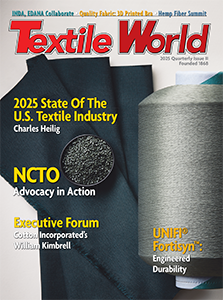AMTEC REORGANIZESThe American Textile Export Co. (AMTEC), which once handled export sales for 39 U.S. companies, reorganized effective Oct. 1 with four shareholders remaining. The new company AMTEC, LLC, is owned by Tuscarora Yarns, Jones Companies, Pharr Yarns and Washington Manufacturing.Peter Hegarty will continue as AMTEC president. Hegarty also assumes global marketing and sales responsibilities for Tuscarora Yarns. He will report to Bud W. Willis, Tuscaroras president and COO. Hegarty will maintain offices in Ranlo, N.C., and at Tuscaroras corporate headquarters in Mt. Pleasant, N.C.October 2001
Worldtex To Close Plant In Lexington S.C.
Worldtex Inc., Hickory, N.C., announced that its wholly owned subsidiary, Elastic Corp. of America
Inc., will permanently close a narrow elastic manufacturing facility located in Lexington, S.C. The
company will continue to operate narrow elastic manufacturing plants in Columbia, Ala.; Woolwine,
Va.; Asheboro, N.C.; and Hemingway, S.C.We are rationalizing our manufacturing for improved
flexibility to meet the changing market demand by consolidating our narrow elastic fabric
operations. Production from Lexington will be shifted to other facilities, said Barry D. Setzer,
CEO. We will continue to operate our most efficient facilities, where a significant amount of
capital expenditures for 1998 and 1999 have been invested. We expect to reduce our manufacturing
cost by this operational restructuring, he added.The closing of the Lexington facility will affect
approximately 150 wage and salaried employees.
January 2001
Thermoadhesives For Wrinkle-Free Seams
France-based Protechnic introduces a thermoadhesive polyethylene film and a copolyester web that
make it easier for manufacturers of wash-and-wear shirts to achieve wrinkle-free seams.The 1/4-,
3/8- and 1/2-inch-wide tapes are inserted into seams of collars, pockets, armholes, cuffs,
buttonholes, side seams and yokes while the shirt is being sewn. Once in place, the thermoadhesive
is activated by heat when the shirt is pressed. Because the polyethylene films and copolyester webs
are totally unaffected by the laundering process, the seams remain flat and undisturbed every time
the consumer washes the garment.
January 2001
Teijin To Acquire Monofilament Business
Japan-based Teijin Ltd. has entered into a basic agreement to acquire the monofilament business of
Johns Manville Corp., Denver. Teijin will obtain all property relating to Johns Manvilles
monofilament business including its monofilament operations in Germany and Spartanburg, S.C. The
agreement remains subject to regulatory approvals in Germany and the United States. Financial
details were not disclosed.The facilities in Germany and Spartanburg, S.C., will be renamed Teijin
Monofilament Germany GmbH and Teijin Monofilament U.S. Inc., respectively.To date, Teijin
Monofilament has been marketing mainly to customers in Japan. The polyester monofilament business
of Teijin and Johns Manville together account for 25 percent of the present worldwide market for
these materials, said Shosaku Yasui, president, Teijin. This agreement with Johns Manville is part
of our strategy to better position Teijin to meet increasingly diverse customer needs throughout
the world.
January 2001
System Cuts Boiler NOx Emissions By Up To 90
BoilersBy Cosby Woodruff, Assistant Editor System Cuts Boiler NOx Emissions By Up To 90%Plants can add boiler capacity without increasing pollution. Environmental awareness has taken its place alongside globalization, specialization and consolidation as trends affecting the way textile companies do business. Along those lines, many companies look for wayshowever smallto reduce operating costs and pollution.Cutting the nitrous oxide emissions (NOx) from a boiler may only make a dent in a plants overall environmental impact, but Nationwide Boiler Inc. recently introduced a catalytic reduction system – CataStak – that reduces NOx emissions by up to 90% over traditional natural-gas fired boiler burners. Nationwides system also reduces carbon monoxide (CO) and volatile organic compounds (VOC). NOx is a key component to smog, and CO and VOC both contribute to air pollution.Nationwide developed CataStak to meet Californias tough, anti-smog laws, company president Jeff Shallcross says, but he expects to receive orders from textile operations through his firms Charlotte office.He predicts it is only a matter of time before national regulations become tougher, and the demand for emission-reducing products grows nationally. “They are getting tighter and tighter on pollution,” Shallcross says. “This is the next step in lower emissions. If plants need to get down below a certain level (of emissions), this is a way they can do it.”He also says CataStak can increase a plants boiler capacity without increasing its total pollution emissions.
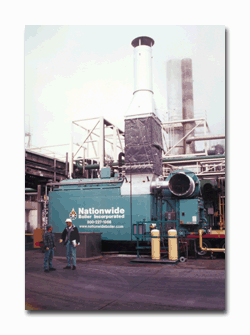
Nationwide’s CataStak reduces boiler emissions of several pollutants, including NOx, CO and VOCs.Installing CataStak does not mean installing a new boiler, or even a new burner. It installs on in-place boiler burners. It is for boilers producing 50,000-150,000 lb/hr, but Shallcross says it can be fitted onto smaller boilers and that it does not reduce boiler efficiency.CataStak operates with three, standard 150-lb ammonia containers instead of a conventional ammonia storage tank. Containers are replaced when empty. The ammonia mixes with the exhaust gases, and the mixture moves through a catalyst in the CataStak, which removes the ammonia and pollutants.CataStak took a year to develop and originally was for Nationwides fleet of rental boilersboilers mounted on 18-wheelers, which are rented to plants undergoing boiler maintenance. Then the company began selling them on new installations in California, then added the product to its retrofitting line. “We were applying it to package boilers,” he says. “Now this is available for direct sales and users.”Nationwide guarantees CataStak to reduce boiler emissions from 30 ppm NOx to 9 ppm. When used with a low NOx burner, it can reduce that to fewer than 3 ppm. Since CataStak is a self-contained box with no large ammonia tanks or vaporizers. Inside the box are a single-reactor with the catalysts and an ammonia-injection skid.Field installation requires a relatively small space, and the device requires little operation intervention. The device is portable and operates at low temperatues. It does not require a special burner or any special exhaust fans. The company began research into NOx reduction more than 15 years ago.November 2001
Clariant Integrates CEP Division
Switzerland-based Clariant Corp. has integrated its cellulose ethers and polymerisates (CEP)
division into the North American organization. The CEP division has 26 production sites in North
America and around the world. The company says the integration will allow Clariant to better serve
its CEP customers, while also providing all customers with complementary products and services from
all six of Clariants global divisions.
CRI Changes Guard
CRI Changes Guard
The Carpet and Rug Institute installs new leadership and initiatives for the coming
year. At its recent annual meeting, the Carpet and Rug Institute (CRI), Dalton, Ga., said
farewell to Ronald E. VanGelderen, its previous president; welcomed Werner Heinz Braun, who has
taken over the helm; and introduced the Executive Committee and Directors. In addition, issues,
barriers, strategies and budget were discussed in detail.The Board of Directors voted to update the
by-laws and appointed an Executive Committee to govern CRI. The Executive Committee for the coming
year includes: Bob Axtell, CEO, DuPont Commercial Flooring Systems; Carl Bouckaert, chairman,
Beaulieu Group LLC; Daniel K. Frierson, chairman, The Dixie Group Inc.; Jeff Lorberbaum, president,
Mohawk Industries Inc.; Robert E. Shaw, chairman, Shaw Industries Inc.; and E.P. (Rusty) Willimon,
general manager, MillikenandCompany. John Swift, treasurer, Mohawk Industries Inc., will serve as
CRIs treasurer.Directors serving a two-year term expiring in 2001 include: Mike Derderian,
president, Royalty Carpet Mills; Walt Hubbard, group president, Fiber Products, BASF; and Julian
Saul, president, Shaw Industries Inc. Directors serving a one-year term expiring in 2001 include:
Jim McCallum, president, Lees Carpets; and Jeffrey Wolff, vice president and general manager,
Solutia Inc. Directors serving a two-year term expiring in 2002 include: Richard Bierie, president,
Mannington Commercial Carpets; Jim Jolly, chairman, J and J Industries Inc.; Richard Prinstein,
vice president, Carpet Fibers, and general manager, Evergreen Nylon Recycling, Honeywell; and
Stuart Thorn, president, Beaulieu Group LLC.Association members include: Certified Floorcoverings
Institute; Association of Georgias Textile, Carpet and Consumer Products Manufacturers; Canadian
Carpet Institute; SB Latex Council; World Floor Covering Association; Floor Covering Adhesives
Manufacturers Committees; National Association of Floor Covering Distributors; Association of
Specialists in Cleaning and Restoration International; Institute of Inspection, Cleaning and
Restoration Certification; American Textile Manufacturers Institute; American Fiber Manufacturers
Association; Floor Covering Installation Contractors; Carpet Cushion Council; International
Certified Floorcovering Installers Association Inc.; and Dalton-Whitfield Chamber of
Commerce. A Fond FarewellVanGelderen served as president and COO of CRI for 20 years. Known in
the industry for a distinctive and proactive leadership style, he was a steward, enhancing
relationships and implementing board policy to resolve industry issues.As international ambassador
for carpet, VanGelderen spearheaded a raising of industry standards in anticipation of consumer
expectations. He vigorously pursued cooperation and encouraged communication among all
floorcovering industry segments.He gained respect throughout the industry for his leadership style,
not only in his efforts toward market expansion, but also because of his compassion, empathy and
integrity. He had a reputation for giving credit to others and making friends of adversaries both
inside and outside the industry. VanGelderen, in his farewell, said, The floorcovering industry is
an industry of people who need each other. Leadership is a humbling experience, and I would like to
thank all of you as my good friends, and I love you dearly.VanGelderen led the carpet industry
through many issues, including installation guidelines, transportation and shipping method
improvement, water effluence and conservation, exporting, hazardous waste compliance and proactive
consumer projects. He served as the lead liaison and spokesperson for the carpet industry during
the Carpet Policy Dialogue, organized and conducted under the aegis of the U.S. Environmental
Protection Agency (EPA), and he perceptively addressed consumer indoor air quality questions
through education and an industry testing program to reduce indoor air pollution and ensure that
carpet, cushion and floorcovering adhesives are environmentally responsible. Changing Of The
GuardBraun, VanGelderens successor as president of CRI, previously was senior director,
international affairs, of the Chlorine Chemistry Council of the Chemical Manufacturers Association.
Prior to that service, he was manager of environmental strategic issues for chemicals and
performance products with Dow Chemical Co., Midland, Mich. His duties during his 30 years with Dow
involved public policy advocacy, issues management, regulatory and governmental affairs management,
and health and environmental affairs management.His awards include the Forest Chemicals Leadership
Award from the National Forest Products Association and the Speakers Award from the American
Chemical Society.Braun earned a B.S. degree in chemistry from St. Edwards University and has taken
graduate courses at Purdue University. He is a member of the Society of Toxicology, and a charter
member of the International Society for Study of Zenobiotics.
January 2001
Sag Harbor To License Name For Hosiery And Seamless
Kellwood Company, New York City, announces a partnership with Glendale Group Ltd., Siler City,
N.C., to produce Sag Harbor hosiery and seamless intimates. Under a licensing agreement with
Kellwood, Glendale Group will design, produce and market the new Sag Harbor product line. The line
includes moderately priced sheer hosiery, trouser socks and seamless intimate apparel. Barbara
McGraw, Sag Harbor brand manager, will serve as the liaison between Kellwood and Glendale, managing
product development and brand identity for the newly licensed products.
January 2001
Herwig Strolz Textiles39 Global Statistician
Leader Of The YearBy John W. McCurry, Managing Editor Herwig Strolz: Textiles’ Global StatisticianLongtime ITMF Director General is Textile World’s Leader of the Year.
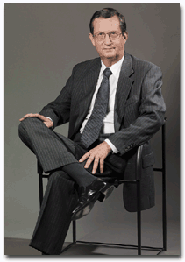
Ask Herwig Strolz a question about worldwide textile machinery shipments and be prepared for an education on the state of the industry. Strolz, director general of the Zurich-based International Textile Mfrs. Federation (ITMF), can offer seemingly unlimited insightful analysis.For example, Strolz believes the U.S. industry is in the midst of a restructuring similar to what its European counterpart experienced in the 1970s. However, what took about 20 years in Europe is on an accelerated pace in the U.S., he believes.”I have thought for a long time that the U.S. will go the way Europe has gone,” Strolz says. “Europe was affected much earlier by globalization. Restructuring of industry started much earlier in the 70s and is still continuing. Companies have learned over a period of time to adapt.” Strolz believes the evolution of the textile industry may take just five years in the U.S. He says to survive, companies must increase flexibility, pay more attention to quality and seek strategic alliances with manufacturers in other countries.”What it will come to is America will have a different textile industry in five years, perhaps even earlier,” Strolz predicts. “Developments are already pointing in that direction. It will be a more versatile, a more quality conscious industry that caters to the upper market segments and pulls out of commodity textiles.”Dan Frierson, chairman of The Dixie Group and a former ITMF president, is a Herwig Strolz fan. He says Strolz has few peers as an industry analyst. “I really think Herwig has done the best analytical work on this industry,” Frierson says. “He is extremely knowledgeable and talented and is a great student of industry trends. If people in the industry listen to him, they will come out ahead.”Frierson says Strolz has been “beating the drum” of overcapacity since the early 1990s, updating his statistical model on installed capacity each year. “He has been very accurate, and candidly, his analysis is one thing that led us to exit the traditional textile business and enter carpet business,” Frierson says.When the worlds textile associations need an expert speaker to dispense a dose of honest industry assessment at an annual conference, they often turn to Strolz, who arguably is a premier tracker of textile trends. One of his recent talks was to the American Yarn Spinners Assn. where he admitted that todays textile market leaves even the most informed observer perplexed. In his speech, which he titled, “Spinning in the Real World,” Strolz told spinning executives their segment has “a giant overcapacity around its neck.” His advice: “excess capacity must be the central point of departure in each spinning companys strategy.”ITMF President Herbert Schmid, president of Brazils huge Santista Textil, a global manufacturer of denim and other fabrics, says Strolz has been involved in every sector of the global textile production process through personal visits, conferences, speeches, committees and publications. “His personal commitment to the industry has been to serve as a bridge between cultures and styles of doing business,through his command of several languages, his unflagging goodwill and his practicality and persistence,” Schmid says.Strolz, one of the worlds premier purveyors of textile industry information, is Textile Worlds 2001 Leader of the Year. He is the first non-industrialist to receive the award. A Global OrganizationITMFs member nations account for about 65% of the worlds textile production. China, which accounts for 20%, is the largest non-member. Strolz expects China may join in the future. “There is a relationship between ITMF and the Chinese industry, but it has not reached the quality of a membership relationship,” he says.An association of associations, ITMF does not have a large staff. Besides Strolz, an assistant director, an economist and a part-time secretary comprise the staff.Strolz, 64, has spent nearly half of his life as head of ITMF. He will observe 32 years with the organization next Jan. 1. During that time, he has enjoyed many professional relationships, which have contributed to his successful tenure. He recalls three men, all former ITMF presidents who are now deceased, who helped him immensely during his early ITMF years.”To be successful, you need a lot of good will on the part of leading people at the helm of any organization,” Strolz says. He cites Craig Smith, former chairman and CEO of Avondale Mills, Tami Guchi, head of Toyoba, the largest textile company in Japan and Mateo Legler, former chief of the huge Legler Group in Italy.Guchi hired Strolz and Smith was the incoming president. Legler also later served as ITMF president. “They all gave me enormous support from the beginning,” Strolz says. “Then there are all my colleagues from associations around the world who have been supportive in our efforts.” ITMF Becomes Authority On Machinery ShipmentsOne of ITMFs greatest accomplishments since Strolz took the reins is the accurate compilation of global textile machinery shipment statistics. In the early 1970s, information of this sort was scarce and consisted mainly of installed capacities in various textile sectors such as spinning and weaving. Today, ITMFs annual “International Textile Machinery Shipment Statistics” is a highly regarded industry publication. The current edition is the product of many years of research and convincing of machinery manufacturers to share information.”In the early 1970s, all we knew were the installed machinery capacities around the world,” Strolz remembers. “It was a good time for the industry in the years leading up to the first oil crisis with machinery manufacturers selling out two or three years in advance, sometimes even more. So, even they had lost sight of investments.”We wanted to go a step further than the information that was available and track investments year to year. At that time, this kind of data was considered absolutely confidential.”What Strolz and ITMF needed was the cooperation of machinery manufacturers. Gradually, Strolz persuaded companies that ITMF could compile the data and then divulge it in a way that would not reveal the number of machines shipped by an individual company. German and Swiss manufacturers were the first to participate and then others joined.
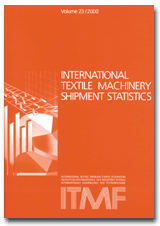
“We started a new thing,” Strolz says. “Today, this is our Number 1 publication, no doubt about it. Nowadays, companies are working with us directly. We dont take any existing trade statistics. We take our questionnaires as they come back from the companies and they provide a picture of investments by the industry today.”The publication continues to grow. Texturing and circular knitting machinery manufacturers joined in recent years and the current issue includes flat knitting machinery figures for the first time.”We can say we are covering somewhere between 95% and 100% of the worlds investment in textile machinery,” Strolz says with a sense of pride.
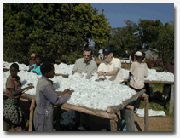
Other ITMF milestones include establishment of various committees for industry segments. Strolz cites the Spinners Committee, in particular. ITMF created the Spinners Committee in 1985 to give the spinning sector a greater voice in matters of interest to the industry. A major objective is to support the development of quality cotton fiber based on modern spinning requirements.”We decided that if we really wanted to bring this industry forward, we needed to seek a dialog between the spinner and the grower of natural fibers,” Strolz said. “In its 16 years, it has grown to 12 members.” Strolz says the committee is representative of the worlds spinning industry. A new member is Andy Warlick, president of Parkdale Mills.The Spinners Committee travels to the worlds cotton growing regions and this summer toured areas of southern Africa. “We try to bring the message from the modern spinning industry to those in the field that produce cotton who have little idea of the constraints of spinning machinery,” Strolz says. Consolidation Of Machinery ManufacturersMirroring trends in textile manufacturing over the last several years, makers of textile machinery are merging and acquiring competitors at a quick clip. Major conglomerates include Saurer, Rieter and Radici. Strolz thinks the trend will continue.”Its in full swing,” he says. “Consolidation is going on in all areas. The essential thrust is toward higher concentration because companies are finding it more difficult to constantly innovate with the volume of business they are doing now.”Still, there remain many major machinery companies in the world, about 150 by Strolzs count with about one-third in China. Expanding ITMF MembershipStrolz enjoys his work with ITMF membership and states a goal of expanding its base, an effort he says is never ending. ITMF represents about 50 nations, although there are some notable exceptions such as China and Mexico.”I cherish my relations with my membership and I want to bring in more members,” Strolz says. “Some have been in and out like the Mexicans. China should have a place in the Federation. I would also like to see the Japanese textile machinery industry join. There is a good chance of this.”
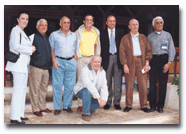
Strolz (center, in yellow shirt) stands with members of the Turkish Textile Employees Association during its meeting in April.ITMF should become more of an “umbrella” organization, expanding both ways in the textile pipeline with increased membership from the fiber and apparel sectors.Interestingly, the U.S. does not have a full member of ITMF since the American Textile Mfrs. Institute left the fold early this year. However, several U.S. associations are associate members, including the American Yarn Spinners Assn., a recent addition. MillikenandCo. and huge Korean fiber manufacturer Huvis Corp. are ITMFs two corporate members.With expanded membership come expanded services. A new initiative is the Young Entrepreneurs Group, which had its first meeting in September at ITMFs annual meeting in Budapest. The group gives young industry leaders (maximum age is 40) a forum to discuss opportunities. Says Strolz, “It brings new blood into the Federation.”The Herwig Strolz BiographyHerwig Strolz was born in Bregenz, Austria, in 1937. He studied law and political science at the University of Vienna where he graduated in 1961 as a doctor in law.Strolz joined the foreign trade department of the Austrian Federal Chamber of Commerce in 1962 and was appointed Assistant Austrian Trade Commissioner in Caracas, Venezuela, the following year. He was transferred to the Austrian Foreign Trade Office in Montreal, in 1966. In 1968 he was appointed director of the Austrian Federation of Industries and assumed managerial responsibilities for the textiles and clothing department of the Chamber of Commerce of Vorarlberg, the province where most of Austria’s textile manufacturing activity is located. Strolz became director of the International Federation of Cotton and Allied Textile Industries (IFCATI) on Jan. 1, 1970, by appointment of the Federation’s Committee of Management at its meeting in Oporto, Portugal, in October 1969. The Federation changed its name to International Textile Mfrs. Federation (ITMF) in 1978. During his term of office ITMF has become the leading global trade association of the primary textile industry with close to 50 of the world’s most important textile producing countries in membership. In 1991 Strolz received the “Golden Jenny Award” of the Schlafhorst Foundation. ITMF Evolves With Industry For 97 YearsThe International Textile Manufacturers Federation (ITMF), founded in 1904 by the British cotton spinning industry, is one of the worlds oldest textile trade associations. Its original name was International Federation of Master Cotton SpinnersandManufacturers Assn. and first headquartered in Manchester, England.In 1954, the organization adjusted to the changing industry and changed its name to International Federation of CottonandAllied Textile Industries. The Federations headquarters moved to Zurich, Switzerland, in 1963 to broaden its international scope. In 1978, the name was changed to International Textile Mfrs. Federation.ITMF membership includes:Full Members are associations and other constituted organizations of manufacturers of textiles. There can be only one member association from each country. Associate Members are associations and other constituted organizations of manufacturers of textiles in countries where there is already a member association; and associations allied to the textile industry. Corporate Members are manufacturers of textiles or of products allied to the textile industry in countries where their respective central trade association is not affiliated with the Federation. Today, ITMF says its main objectives are toprovide a forum for discussion of matters appropriately within the common interest and concern of textile companies. provide a neutral meeting ground for textile trade associations for the exchange of information on matters affecting their textile industries, consistent with the trade regulation laws of the nations represented. act as a central agency of the textile industries for the collection of information, statistical and otherwise, on textile manufacturing developments in all countries of the world. act as spokesman for the world textile industry in matters relating to raw materials (cotton and manmade fibers). perform the functions of a liaison agent between the textile industries and governments and intergovernmental organizations interested in the textile industry. October 2001
SSM And Fadis Reach Patent Agreement
SSM AND FADIS REACH PATENT AGREEMENTSSM Schr Schweiter Mettler AG and Fadis SpA signed a license agreement which includes the use of patents for electronic yarn-guiding system. The deal resolves a patent infringement dispute that originated during ITMA 1999.The license agreement authorizes Fadis to use SSM patents for the production and the incorporation of electronic yarn-guide systems in its entire Syncro winder line. SSM has been delivering this technology since 1995 and has sold about 40,000 units.November 2001

